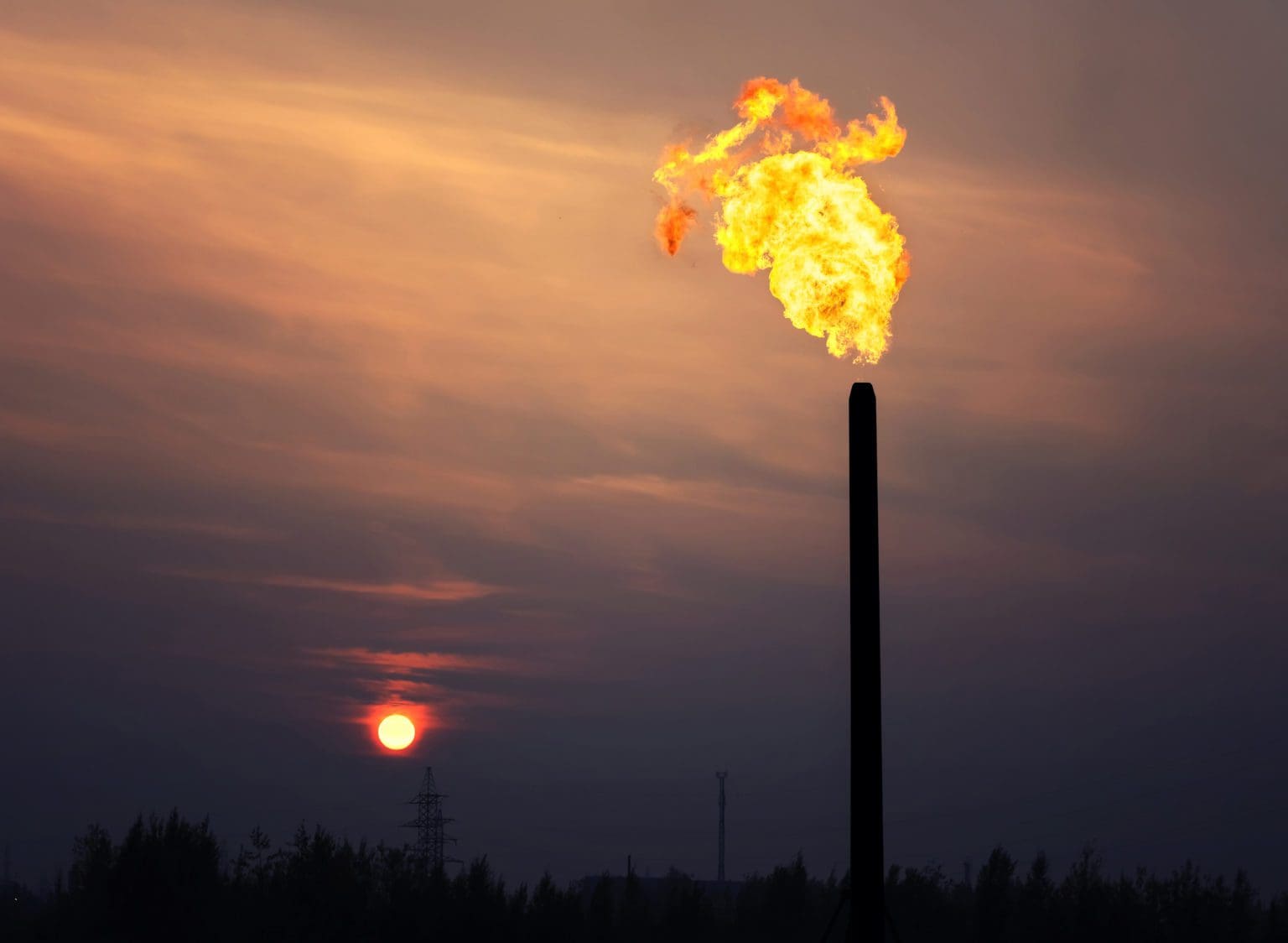While most climate-related legislation is focused on reducing CO2 emissions, a much more potent and dangerous greenhouse gas is often ignored. Methane is about 80 times more powerful at warming the atmosphere than carbon dioxide, and yet, methane emissions are largely unregulated. What’s more, climate change is causing permafrost to thaw which releases even more methane. If these emissions remain largely unchecked, all other climate action will be in vain.
Unregulated Emissions
Recently, Texas and California have come under fire for excess methane emissions. To the naked eye the oil wells operated by West Texas Gas Inc. are unremarkable as there are thousands and thousands of similar operations scattered all across the Permian Basin.
What is not unremarkable is the amount of methane these oil wells emit. The stations were observed releasing 870 kilograms of methane into the atmosphere hourly. To put that number into perspective, it is like burning seven tanker trucks full of gasoline every day. Even though methane is invisible to the human eye, it is extremely harmful for the environment.
Satellites to Fight Emissions
Satellites are becoming a tool to fight climate change, exposing hidden sources of emissions and allowing authorities to monitor compliance with international climate deals. Over the past three years, methane leaks that had gone undetected as well as estimates of known emissions that were underestimated have been discovered, among other places, in Russia, Turkmenistan, and the Permian Basin of Texas. In some cases, these discoveries have led to international tensions.
Satellites are becoming a tool to fight climate change
Private businesses, environmental watchdogs, and others have made these disclosures using information from multipurpose satellites owned by space agencies. Additionally, dozens of specialized satellites completely dedicated to searching the planet for greenhouse gas leaks are being launched by governments, private corporations, and environmental organisations.
Concerns About Satellites
Several nations have voiced their concerns about the possibility of rivals using satellite photography to “name and shame” them for pollution. According to Stephane Germain, CEO of the Canadian satellite company GHGSat Inc., which monitors emissions, China in particular has made it clear that it wants to restrict monitoring within its own borders and views such satellites as a national security concern.
‘The overarching concern is they’re being monitored from space,’ Mr. Germain said.
This reasoning may just be a pretext to stay unaccountable, as multinational businesses have been using satellites for monitoring anything from Chinese steel production to shopper traffic at American malls. Major oil companies self-monitor their emissions in a bid to show compliance with clean-air standards.
‘It’s going to provide leakers with very few places to hide,’ said Tim Gould, chief energy economist at the Paris-based International Energy Agency, commenting on satellite monitoring.
Texas
Consequently, the West Texas Gas Inc. emissions were also detected among hundreds of other ‘super emitters’ during a 2021 aerial survey of the Permian Basin by Carbon Mapper, a partnership of university researchers and NASA.
The researchers found that the Permian, a 250-mile-wide bone-dry region along the Texas-New Mexico border that was once the bottom of a shallow sea, was releasing enormous amounts of methane into the atmosphere from oil and gas operations. Hundreds of the locations could be observed repeatedly releasing the gas
‘We see the same sites active from year to year. It’s not just month to month or season to season,’ said Riley Duren, a research scientist at the University of Arizona who leads Carbon Mapper.
According to an analysis conducted by the Associated Press, in which they cross-referenced the GPS coordinates of the ‘super emitter’s sites and drilling permits, maps and land records, just 10 companies owned at least 164 sites of the 500+ sites in the Basin.
What’s unusual about this kind of pollution is that well operators are wasting the product they are there to extract. Methane is not a by-product or waste; it is a target gas that companies aim for and sell.
Despite investments, the pipelines do not have sufficient capacity to gather and transport all the gases. As a result, gases are routinely burned off.
In 2016, then President Barack Obama announced a Climate Action Plan that included rules for the oil and gas sector to cut methane emissions by 40 per cent by 2025.
Unfortunately, President Donald Trump, who denied climate change is real and called it a Chinese-hoax, scrapped the policies before they were to take effect.
On the first day of his administration, President Joe Biden ordered the Environmental Protection Agency to reinstate some Obama-era rules and form new ones. Some of the proposed legislation is still under review.
California
Though California limits climate pollution and the rules get stricter each year and the state claims to know how much climate-warming gas is going into the air from within its borders, they do not include methane leaks from idle oil wells into their calculations.
The authorities are aware of 35 thousand old, inactive oil and gas wells that leak methane. According to Ira Leifer, an independent scientist and CEO of Bubbleology Research International, this calls into question California’s ability to meet its carbon-neutrality goals by 2045.
For years, locals and environmentalists from all across the state have expressed concern about the risk of leaks from dormant or abandoned wells, but in May and June, it was found that 21 idle wells in or close to two Bakersfield neighbourhoods were emitting methane. They claim that the leaky wells are “an urgent public health issue” since other gases frequently escape alongside methane.
‘Those other gases have significant health impacts,’ Leifer said, yet we know even less about their quantities than we do about methane.
In a bid to slash emissions, California Governor Gavin Newsom signed a budget called Methane Accountability Project. The state will spend $100 million to track methane leaks with satellites.
In a similar vein, a new Senate proposal would also provide hundreds of millions to plug wells and decrease pollution.
Permafrost
Not all methane emission is a direct result of human activity. As climate change gradually warms the planet, methane trapped in permafrost will be set free due to the melting ice. As more and more methane is released the ice will melt faster leading to a dangerous feedback loop.
Permafrost thawing in Siberia has raised concerns among climate experts recently that it could be a “methane time bomb” that goes off gradually. As temperatures rise in Russia’s far north, massive amounts of methane are being released into the atmosphere. A peer-reviewed study using satellite imagery and a review by an international organization have now issued warnings about this.
It could be a “methane time bomb”
Interpreting the data of the study correctly may be the difference between ‘catastrophe and apocalypse’ according to geoscientists.
“The story is simple,” the report concludes. “Climate change is happening faster than anticipated. One consequence—the loss of ice in the polar regions—is also a driver for more rapid global heating and disastrously rapid global sea level rise.”
Reports caution that due to the feedback loops an ‘irreversible’ tipping point is approaching for the Arctic.
Code Red
Biden said that humanity was running out of time, calling the climate crisis a ‘code red for humanity.’
‘I will do everything in my power to clean our air and water, protect our people’s health, to win the clean energy future. Our children and grandchildren are counting on us.’
Despite his pledges, Biden has refused to formally declare an emergency that would give him more executive power to ramp up renewable production, though he has introduced a climate bill that would move the needle in the right direction.
As Kassie Siegel, director of the Climate Law Institute at the Center for Biological Diversity put it, ‘If carbon dioxide is the fossil-fuel broiler of our heating planet, methane is a blowtorch.’ It is crucially important to act immediately and cut emissions to the minimum, or the damage will be irreversible and fatal on a global level. Not only are companies wasting methane in the midst of an energy crisis and heavily polluting the environment, they are also worsening the permafrost thawing which results in even more excess methane – clearly a recipe for disaster.








